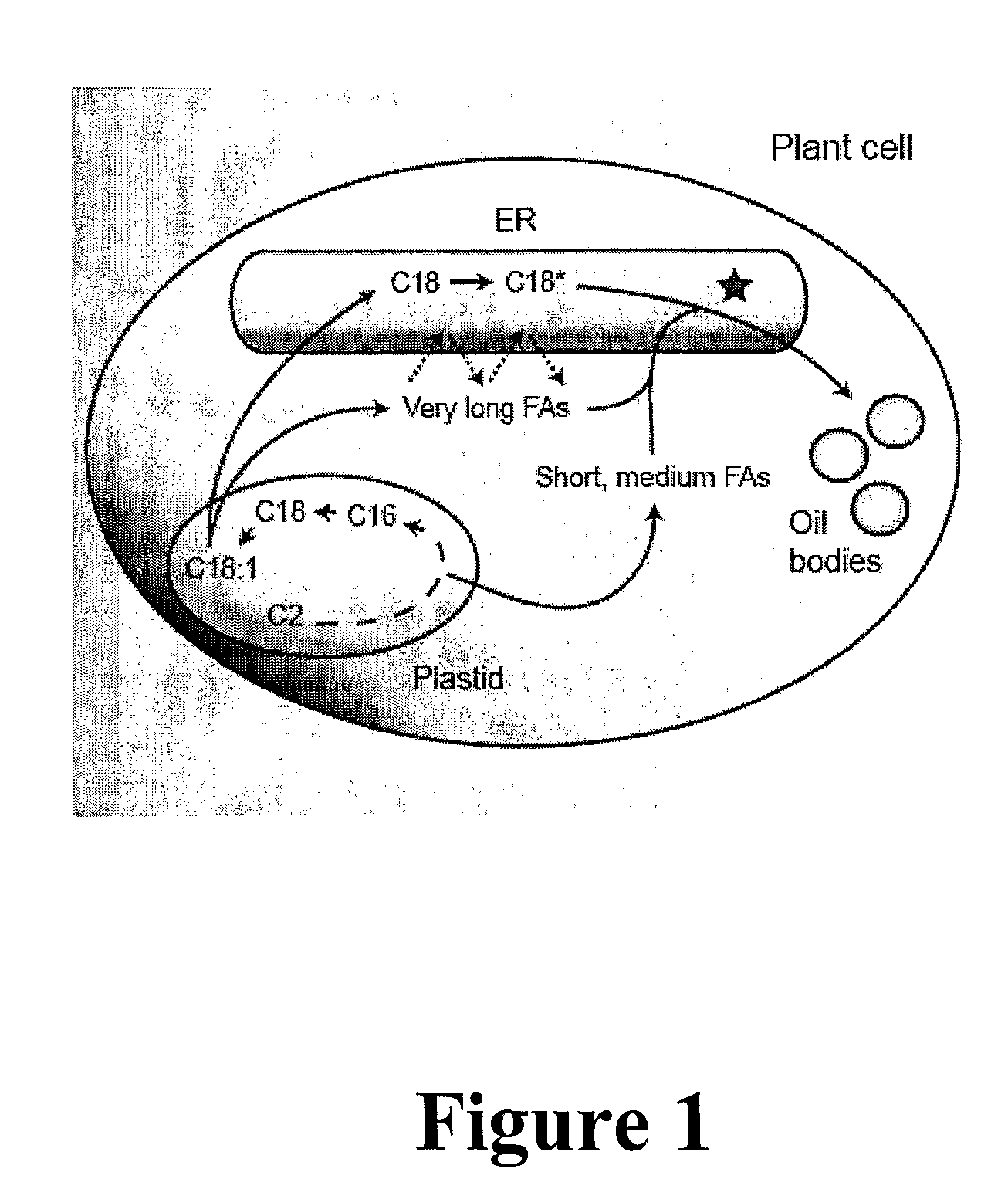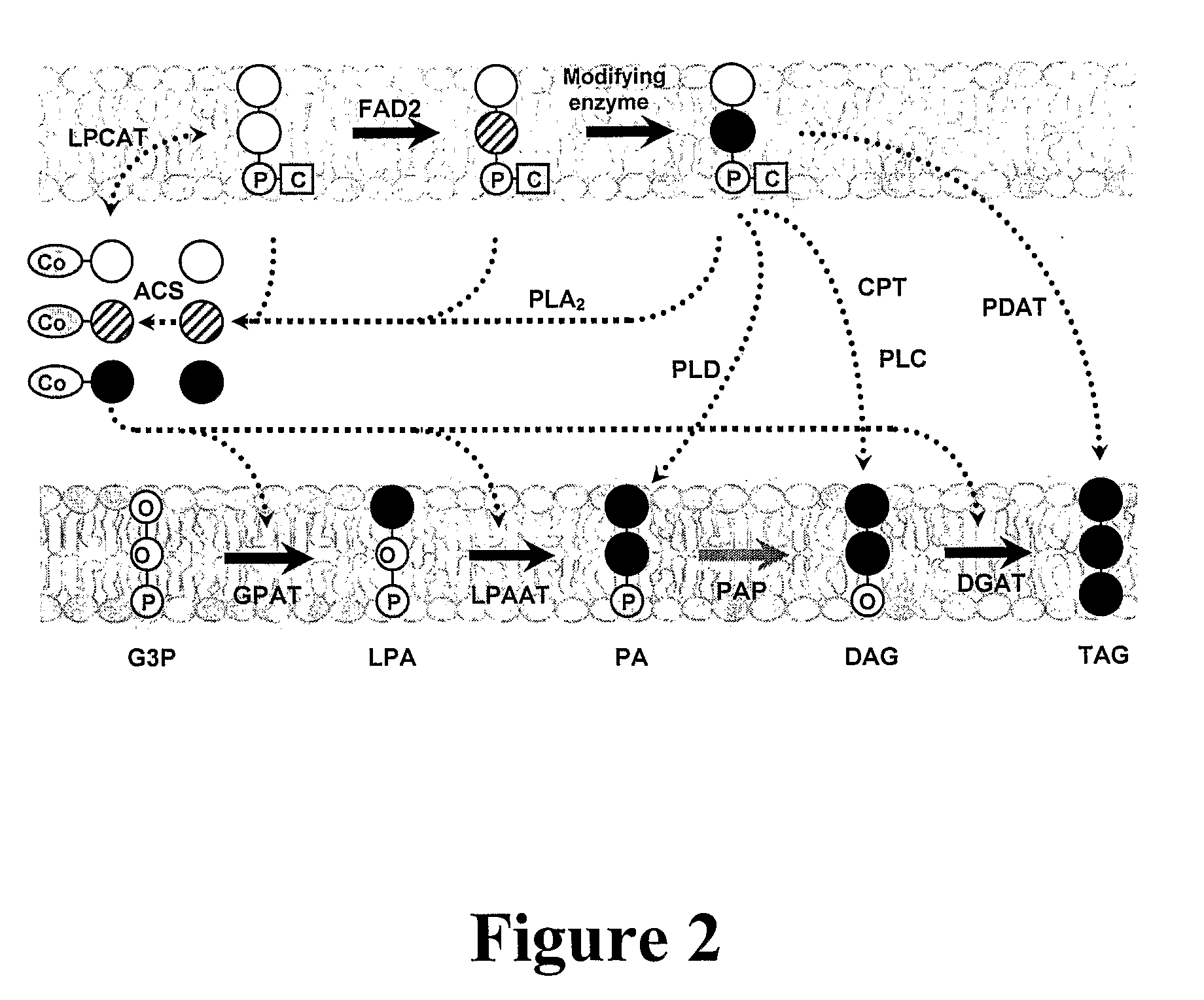Polypeptides and methods for producing triacylglycerols comprising modified fatty acids
a technology of glycerol and polypeptide, which is applied in the field of polypeptides and methods for producing triacylglycerols comprising modified fatty acids, can solve the problems of low mfa, poor ability, and modest success, and achieve the effect of purifying the fusion protein and enhancing the stability of the polypeptid
- Summary
- Abstract
- Description
- Claims
- Application Information
AI Technical Summary
Benefits of technology
Problems solved by technology
Method used
Image
Examples
example 1
Materials and Methods
Developing Embryos
[0617]Seed of Bernardia pulchella, a dioecious Euphorbia species containing 90% vernolic acid in its seeds, were obtained from Belgium Botanical Gardens and used to establish plants in the glasshouse. Flowers on male and female plants were intercrossed using brush pollination techniques. Green developing embryos were harvested at a range of different growth stages as described below.
Construction of Bernardia pulchella cDNA Library
[0618]Total RNA was isolated from developing seeds ranging 4-8 mm in size using Trizol reagent (Invitrogen) according to the instructions of the supplier. Messenger RNA was purified from total RNA using an Oligotex mRNA kit (Qiagen). First strand cDNA was synthesised from 5 μg mRNA using an oligo-dT primer supplied with the λ ZAP II-cDNA synthesis kit (Stratagene—Catalogue No. 200400) and reverse transcriptase SuperscriptIII (Invitrogen). Double stranded cDNA was ligated to EcoRI / XhoI adaptors and from this a library w...
example 2
Isolation and Expression of B. pulchella Diacylglycerol Acyltransferase 2 (BpDGAT2)
[0628]Acyl CoA:diacylglycerol acyltransferase (EC 2.3.1.20; DGAT) catalyzes the final step in TAG assembly by transferring a fatty acyl group from acyl-CoA to a diacylglycerol substrate. Three different, structurally unrelated DGAT enzymes have been identified in plants. Since they have the same enzyme activity, they are isoenzymes. The first two to be identified were DGAT1 and DGAT2, both of which were endoplasmic reticulum (ER)-localized and contained predicted membrane spanning domains (Hobbs et al., 2000; Zou et al. 1999; Lardizabal et al., 2001). The third enzyme was a soluble DGAT (DGAT3), which was recently identified in peanut (Saha et al., 2006) but has not been characterized in other species.
[0629]Although type 2 diacylglycerol acyltransferase genes (DGAT2) encode proteins with DGAT activity, they are unrelated in amino acid sequence to proteins encoded by DGAT1 gene family as determined by ...
example 3
Isolation and Expression of Genes Encoding Diacylglycerol Acyltransferase 1 (DGAT1)
[0635]Cloning of Arabidopsis thaliana AtDGAT1
[0636]A DNA fragment containing the full-length Arabidopsis thaliana protein coding region encoding diacylglycerol acyltransferase 1 gene (AtDGAT1; gene At2g19450) was amplified from stem cDNA with proof-reading polymerase PfuUltraII (Stratagene) and primers:—
AtDGAT1-F1(SEQ ID NO: 86)5′-TCGGGTACCGCTTTTCGAAATGGCGAT-3′andAtDGAT1-R1(SEQ ID NO: 87)5′-TTGGATATCGACGTCATGACATCGATCCTTTTC-3′
and inserted into a pBluescript SK (Stratagene) derivative, resulting in plasmid pXZP163. After confirming the nucleotide sequence of the coding region, the gene was cleaved out and subcloned into binary vector pWVec8-Fp1 (Singh et al., 2001), generating plasmid pXZP307, for expression in transgenic plants by the methods described in Example 1.
Cloning of Bernardia pulchella Gene Encoding DGAT1 (BpDGAT1) by Screening cDNA Library
[0637]A radioactive probe prepared from the full-len...
PUM
| Property | Measurement | Unit |
|---|---|---|
| mol % | aaaaa | aaaaa |
| mol % | aaaaa | aaaaa |
| mol % | aaaaa | aaaaa |
Abstract
Description
Claims
Application Information
 Login to View More
Login to View More - R&D
- Intellectual Property
- Life Sciences
- Materials
- Tech Scout
- Unparalleled Data Quality
- Higher Quality Content
- 60% Fewer Hallucinations
Browse by: Latest US Patents, China's latest patents, Technical Efficacy Thesaurus, Application Domain, Technology Topic, Popular Technical Reports.
© 2025 PatSnap. All rights reserved.Legal|Privacy policy|Modern Slavery Act Transparency Statement|Sitemap|About US| Contact US: help@patsnap.com


